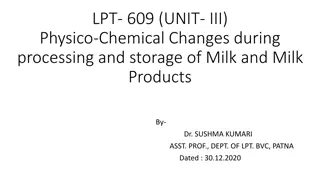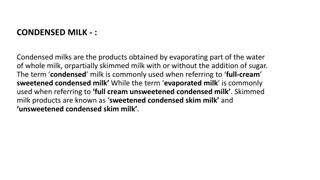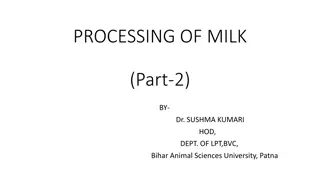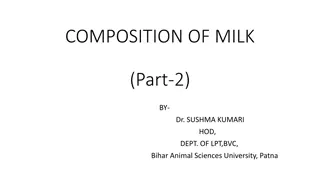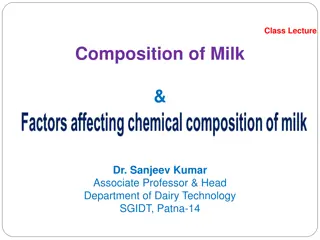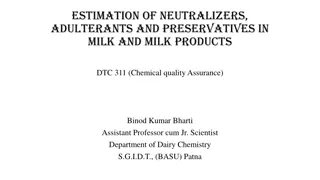Understanding the Physico-Chemical Properties of Milk - Part 1 by Dr. Sushma Kumari
Physical and chemical properties of milk including its physical state, acidity levels, pH, density, freezing point, color, and flavor are discussed in detail in this informative article by Dr. Sushma Kumari from Bihar Animal Sciences University. Key points covered include the nature of milk constituents, acidity variations, pH significance, freezing point behavior, and factors affecting milk flavor. The content also explores the impact of different types of milk on these properties, offering a comprehensive understanding of milk quality.
Download Presentation

Please find below an Image/Link to download the presentation.
The content on the website is provided AS IS for your information and personal use only. It may not be sold, licensed, or shared on other websites without obtaining consent from the author. Download presentation by click this link. If you encounter any issues during the download, it is possible that the publisher has removed the file from their server.
E N D
Presentation Transcript
PROPERTIES OF MILK (Part-1) BY- Dr. SUSHMA KUMARI HOD, DEPT. OF LPT,BVC, Bihar Animal Sciences University, Patna
Physico- chemical properties of milk 1. Physical state of milk- water is the continuous phase in which other constituents are dissolved or suspended. Protein and minerals are found as colloidal suspension and fat as emulsion. 2. Acidity of milk- Freshly drawn milk is amphoteric to litmus i.e. It turns red litmus blue and vice versa. However milk shows a certain acidity as determined by Titration with an alkali (NaoH) in presence of an indicator (phenolphthalein) . This acidity is known as titratable acidity (T.A.).
Natural or apparent acidity (N.A.)- due to presence of casein, acid- phosphates , citrates etc. in milk. The higher the SNF content of milk higher is the N.A. of milk and vice versa. T.A. of cow milk varies from 0.13-0.14 %. Buffalo milk = 0.14-0.15%. Developed or Real acidity- due to lactic acid formed in the milk as a result of bacterial action on lactose in the milk. Titrable acidity= N.A.+ developed acidity
3. pH of milk- Higher pH values indicate udder infection (mastitis) While lower pH values indicate bacterial action. 4.Density and specific gravity - D = mass/ volume Sp.gr= density of substance/ density of water The density or sp.gr. of milk may be determined by Pycnometer or Hydrometer or Lactometer. Milk is heavier than water. Av. Sp.gr. of cow milk (60 F) = 1.028 to 1.030 Av. sp.gr. of buffalo milk = 1.030 to 1.032 The sp gr. of milk is lowered by addition of water & cream and increased by addition of skim milk or removal of fat. normal fresh cow milk =6.4-6.6 buffalo milk = 6.7-6.8
5. Freezing point of milk Milk freezes at temp. slightly lower than water due to presence of soluble constituents. Av. F.pt. of cow milk= 0.54 C buff. Milk = 0.55 C Mastitis milk shows normal F.pt. Lowering of f.pt indicates addition of water. 6. Colour of milk- casein , fat globules and carotene. Buffalo milk = white Cow mik= light yellow Skim milk = light bluish Whey = greenish yellow
7. Flavour- The fat, fatty acids and phospholipids also contribute to the flavour. odour(smell) + taste Sweetish taste due to lactose. Salty taste due to more minerals.


